The Impact of Thin Asphalt Layers as a Road Traffic Noise Intervention in an Urban Environment
Abstract
:1. Introduction
2. Materials and Methods
2.1. Experimental Setup
2.1.1. Streets Equipped with TALs
- Location A: the average section length was 158 m. A new base layer was laid was recommend by guidelines from the Flemish road administration (SB250), in asphalt type APO-B (Dmax 14 mm), with 6 cm thickness, over a foundation composed of crushed stone. As a wearing course, three sections were laid in commercially available TALs, with 3 cm thickness, and two reference sections were built in SMA, with 10 and 6.3 mm maximum aggregate size and 4 cm thickness.
- Location B: the sections presented an average length of 211 m. The foundation of crushed stone had approximately 28 cm thickness. Only part of the original base layer (type APO-B, Dmax 14 mm and 6 cm thickness) was replaced in order to reduce the costs and to obtain a different pavement than in location A. The existing wearing course (Dense Asphalt Concrete 0/10), laid 3 years before the TALs installation, was kept as a reference section (REF-B) due to its good condition. For the TALs construction, the wearing course was milled in 3 cm: the exact TALs thickness. Besides the three types of TALs used at location A, location B included two more sections in two different commercial TALs. The TAL sections at location B are hereafter named TAL-B1, TAL-B2, TAL-B3, TAL-B4 and TAL-B5. These TAL mixtures had maximum aggregate sizes of 5.8 to 6.3 mm and void contents ranging between 10 and 21%, classified as porous or semi-porous. Figure 2 presents the sections in location B, with the TALs’ commercial names. These were unrelated to the section numbering due to the anonymization agreements with the contractors.
2.1.2. Control Group
2.2. CPX and SPB Measurements
2.3. Noise Modelling
2.4. Self-Administered Surveys
2.4.1. Content, Delivery and Response Rate
- Annoyance: the extent of noise annoyance (all noise sources) in and around the house, perceived over the previous year, as formulated in Question 14_1: “Thinking about the last 12 months, to what extent were you annoyed by sound in and around your home?”. Response categories: Not at all (1), Slightly (2), Moderately (3), Very (4), and Extremely annoyed (5);
- Change in annoyance (ΔAnnoyance): the reported change in Annoyance (all noise sources) over the previous two years, assessed in Question 15_1: “Thinking about your situation at home, in and around your house, to what extent has the annoyance caused by noise changed during the past 2 years?”. Response categories: Greatly reduced (−2), Slightly reduced (−1), Remained the same (0), Slightly increased (+1), and Greatly increased (+2);
- Road traffic noise annoyance (RTA): the extent of annoyance caused specifically by road traffic noise, as formulated in Question 16_3: “To what extent are you annoyed by the following noise sources?”. Seven different noise sources were mentioned, including road traffic noise. Response categories: Not at all (1), Slightly (2), Moderately (3), Very (4), and Extremely annoyed (5);
- Domain 1 (Physical complaints): the frequency respondents reported experiencing symptoms related to different health problems (headaches, fatigue, dizziness, insomnia, heart palpitations, and gastrointestinal complaints);
- Domain 2 (Sleep quality): sleep duration and time needed to fall asleep, the frequency of feeling well-rested, waking up too early, or having difficulty waking up;
- Domain 3 (Comfort level to perform activities): comfort level to conduct activities indoors and outdoors, as concentrating during working or studying, reading or watching television, speech intelligibility during a phone call or conversation, and relaxing or unwinding.
2.4.2. Statistical Analysis
2.4.3. Sociodemographic Data
3. Effectiveness of the Noise Intervention
3.1. CPX and SPB Results
3.2. Noise Exposure and Noise Maps
4. Effectiveness of the Noise Intervention
4.1. Direct Subjective Perceived Noise: Annoyance Indicators
- The average Annoyance in the control streets (2.23 ± 0.99) indicates that respondents are ‘slightly annoyed’, compared to an average of 2.75 ± 1.11 (close to ‘moderately annoyed’) in pre-survey on the experimental streets. A similar condition is reported for RTA. For both indicators, the mean ranks difference is statistically significant. This contrast partially justifies the implementation of a noise intervention;
- After the TAL construction, the ΔAnnoyance scores reveal that the residents experienced a lesser increase in annoyance by noise over the 1-year window prior to the post-surveys than before the pre-survey. Therefore, the residents report positively experiencing a change in Annoyance and RTA, most likely attributed to the noise intervention;
- In the first post-survey, Annoyance and RTA have decreased in comparison to the pre-survey and are no longer significantly different from the control groups, where the average noise annoyance is close to the Flemish average reported in SLO-4 [42] (Annoyance = 2.11 and RTA = 2.19; based on >5000 respondents). This effect appears to be sustained even at the time of the second post-survey;
- The three noise indicators did not differ statistically between post 1 and post 2. Thus, the lower traffic intensity might not be as influential on the reported subjective indicators as we anticipated, at least not in the short term;
- Similar means for Annoyance and RTA across all cases possibly indicate that either the respondents did not differentiate between the noise sources causing annoyance or road traffic noise is clearly identified as the main source of Annoyance in general. The last option is more reasonable, as RTA is distinguishably the highest among the annoyances from the different noise sources: the second higher reported mean annoyance comes from ‘priority vehicles (ambulances, fire trucks, etc.)’, ranging from 1.64 to 1.78 across the three cases.
4.2. Indirect Subjective Perceived Noise: Physical Complaints, Quality of Sleep and Comfort Level to Perform Activities
4.3. The Influence of Sociodemographics on Direct/Indirect Subjective Noise Indicators
5. Summary and Conclusions
6. Limitations and Outlook
Author Contributions
Funding
Institutional Review Board Statement
Informed Consent Statement
Data Availability Statement
Acknowledgments
Conflicts of Interest
References
- Hänninen, O.; Knol, A.B.; Jantunen, M.; Lim, T.-A.; Conrad, A.; Rappolder, M.; Carrer, P.; Fanetti, A.-C.; Kim, R.; Buekers, J.; et al. Environmental Burden of Disease in Europe: Assessing Nine Risk Factors in Six Countries. Environ. Health Perspect. 2014, 122, 439–446. [Google Scholar] [CrossRef] [Green Version]
- Ögren, M.; Molnár, P.; Barregard, L. Road traffic noise abatement scenarios in Gothenburg 2015–2035. Environ. Res. 2018, 164, 516–521. [Google Scholar] [CrossRef] [PubMed]
- Basner, M.; Babisch, W.; Davis, A.; Brink, M.; Clark, C.; Janssen, S.; Stansfeld, S. Auditory and non-auditory effects of noise on health. Lancet 2014, 383, 1325–1332. [Google Scholar] [CrossRef] [Green Version]
- Guski, R.; Schreckenberg, D.; Schuemer, R. WHO Environmental Noise Guidelines for the European Region: A Systematic Review on Environmental Noise and Annoyance. Int. J. Environ. Res. Public Health 2017, 14, 1539. [Google Scholar] [CrossRef] [PubMed] [Green Version]
- Brink, M.; Schäffer, B.; Vienneau, D.; Foraster, M.; Pieren, R.; Eze, I.C.; Cajochen, C.; Probst-Hensch, N.; Röösli, M.; Wunderli, J.-M. A survey on exposure-response relationships for road, rail, and aircraft noise annoyance: Differences between continuous and intermittent noise. Environ. Int. 2019, 125, 277–290. [Google Scholar] [CrossRef] [PubMed]
- Miedema, H.M.E.; Oudshoorn, C.G. Annoyance from transportation noise: Relationships with exposure metrics DNL and DENL and their confidence intervals. Environ. Health Perspect. 2001, 109, 409–416. [Google Scholar] [CrossRef] [PubMed]
- Hong, J.; Lee, S.; Lim, C.; Kim, J.; Kim, K.; Kim, G. Community annoyance toward transportation noise: Review of a 4-year comprehensive survey in Korea. Appl. Acoust. 2018, 139, 229–234. [Google Scholar] [CrossRef]
- Ascigil-Dincer, M.; Demirkaleb, S. Model development for traffic noise annoyance prediction. Appl. Acoust. 2021, 177, 229–234. [Google Scholar] [CrossRef]
- Asutay, E.; Västfjäll, D. Perception of loudness is influenced by emotion. PLoS ONE 2012, 7, e38660. [Google Scholar] [CrossRef] [Green Version]
- Crichton, F.; Dodd, G.; Schmid, G.; Petrie, K.J. Framing sound: Using expectations to reduce environmental noise annoyance. Environ. Res. 2015, 142, 609–614. [Google Scholar] [CrossRef] [PubMed]
- Fields, J.M. Effect of personal and situational variables on noise annoyance in residential areas. J. Acoust. Soc. Am. 1993, 93, 2753–2763. [Google Scholar] [CrossRef]
- Miedema, H.M.E.; Vos, H. Demographic and attitudinal factors that modify annoyance from transportation noise. J. Acoust. Soc. Am. 1999, 105, 3336–3344. [Google Scholar] [CrossRef]
- Pershagen, G.; Van Kempen, E.; Casas, M.; Foraster, M. Traffic noise and ischemic heart disease—Review of the evidence for the WHO environmental noise guidelines for the European region. Eur. Heart J. 2017, 38, 710. [Google Scholar] [CrossRef] [Green Version]
- E Beutel, M.; Brähler, E.; Ernst, M.; Klein, E.; Reiner, I.; Wiltink, J.; Michal, M.; Wild, P.S.; Schulz, A.; Münzel, T.; et al. Noise annoyance predicts symptoms of depression, anxiety and sleep disturbance 5 years later. Findings from the Gutenberg Health Study. Eur. J. Public Health 2020, 30, 487–492. [Google Scholar] [CrossRef] [PubMed]
- Okokon, E.O.; Yli-Tuomi, T.; Turunen, A.W.; Tiittanen, P.; Juutilainen, J.; Lanki, T. Traffic noise, noise annoyance and psychotropic medication use. Environ. Int. 2018, 119, 287–294. [Google Scholar] [CrossRef]
- Bodin, T.; Björk, J.; Ardö, J.; Albin, M. Annoyance, Sleep and Concentration Problems due to Combined Traffic Noise and the Benefit of Quiet Side. Int. J. Environ. Res. Public Health 2015, 12, 1612–1628. [Google Scholar] [CrossRef] [PubMed]
- Wang, H.; Gao, H.; Cai, M. Simulation of traffic noise both indoors and outdoors based on an integrated geometric acoustics method. Build. Environ. 2019, 160, 106201. [Google Scholar] [CrossRef]
- Stansfels, S.; Clark, C. Health Effects of Noise Exposure in Children. Curr. Environ. Health Rep. 2015, 2, 171–178. [Google Scholar] [CrossRef] [PubMed] [Green Version]
- Babisch, W.; Beule, B.; Schust, M.; Kersten, N.; Ising, H. Traffic Noise and Risk of Myocardial Infarction. Epidemiology 2005, 16, 33–40. [Google Scholar] [CrossRef]
- Petri, D.; Licitra, G.; Vigotti, M.A.; Fredianelli, L. Effects of Exposure to Road, Railway, Airport and Recreational Noise on Blood Pressure and Hypertension. Int. J. Environ. Res. Public Health 2021, 18, 9145. [Google Scholar] [CrossRef]
- Dratva, J.; Phuleria, H.C.; Foraster, M.; Gaspoz, J.-M.; Keidel, D.; Künzli, N.; Liu, L.-J.S.; Pons, M.; Zemp, E.; Gerbase, M.W.; et al. Transportation Noise and Blood Pressure in a Population-Based Sample of Adults. Environ. Health Perspect. 2012, 120, 50–55. [Google Scholar] [CrossRef] [PubMed]
- European Parliament, Council of the European Union. Assessment and management of environmental noise. In Directive 2002/49/EC of the European Parliament and of the Council of 25 June 2002; 32002L0049; European Commission: Brussels, Belgium, 2002. [Google Scholar]
- Felcyn, J.; Preis, A.; Kokowski, P.; Gałuszka, M. A comparison of noise mapping data and people’s assessment of annoyance: How can noise action plans be improved? Transp. Res. Part D Transp. Environ. 2018, 63, 72–120. [Google Scholar] [CrossRef]
- Directive, E. Commission Directive (EU) 2015/996 of 19 May 2015 Establishing Common Noise Assessment Methods according to Directive 2002/49/EC of the European Parliament and of the Council; 32015L0996R(01); European Commission: Brussels, Belgium, 2015. [Google Scholar]
- Murphy, E.; Faulkner, J.P.; Douglas, O. Current State-of-the-Art and New Directions in Strategic Environmental Noise Mapping. Curr. Pollut. Rep. 2020, 6, 54–64. [Google Scholar] [CrossRef]
- Nilsson, M.; Bengtsson, J.; Klaeboe, R. Environmental Methods for Transport Noise Reduction, 1st ed.; CRC Press: London, UK, 2014. [Google Scholar]
- Brown, A.L.; van Kamp, I. WHO Environmental Noise Guidelines for the European Region: A Systematic Review of Transport Noise Interventions and Their Impacts on Health. Int. J. Environ. Res. Public Health 2017, 14, 873. [Google Scholar] [CrossRef] [Green Version]
- Sandberg, U.; Ejsmont, J. Tyre/Road Noise Reference Book; Informex: Kisa, Sweden, 2002. [Google Scholar]
- Bianco, F.; Fredianelli, L.; Castro, F.L.; Gagliardi, P.; Fidecaro, F.; Licitra, G. Stabilization of a p-u Sensor Mounted on a Vehicle for Measuring the Acoustic Impedance of Road Surfaces. Sensors 2020, 20, 1239. [Google Scholar] [CrossRef] [Green Version]
- Gateano, L.; Mauro, C.; Elena, A. Noise monitoring within LIFE NEREiDE: Methods and results. In Proceedings of the Inter-Noise 2019: The 48th International Congress and Exhibition on Noise Control Engineering, Madrid, Spain, 16–19 June 2019. [Google Scholar]
- Del Pizzo, A.; Teti, L.; Moro, A.; Bianco, F.; Fredianelli, L.; Licitra, G. Influence of texture on tyre road noise spectra in rubberized pavements. Appl. Acoust. 2020, 159, 107080. [Google Scholar] [CrossRef]
- Biligri, K.P. Effect of pavement materials’ damping properties on tyre/road noise characteristics. Constr. Build. Mater. 2013, 49, 223–232. [Google Scholar] [CrossRef]
- Merskaa, O.; Mieczkowski, P.; Żymełkaa, D. Low-noise Thin Surface Course—Evaluation of the Effectiveness of Noise Reduction. Transp. Res. Procedia 2016, 14, 2688–2697. [Google Scholar] [CrossRef] [Green Version]
- Vaitkus, A.; Andriejauskas, T.; Vorobjovas, V.; Jagniatinskis, A.; Fiks, B.; Zofka, E. Asphalt wearing course optimization for road traffic noise reduction. Constr. Build. Mater. 2017, 152, 345–356. [Google Scholar] [CrossRef]
- Pedersen, T.H.; Le Ray, G.; Bendtsen, H.; Bendtsen, J. Community Response to Noise Reducing Road Pavements. Rapport Nr. 502; Danish Road Directorate (Vejdirektoratet): Copenhagen, Denmark, 2014.
- Lo Castro, F.; Iarossi, S.; Massimiliano, L.; Bernardini, M. Life NEREiDE project: Preliminary evaluation of road traffic noise after new pavement laying. In Proceedings of the Inter-Noise 2019: The 48th International Congress and Exhibition on Noise Control Engineering, Madrid, Spain, 16–19 June 2019. [Google Scholar]
- Torija, A.J.; Flindell, I.H. Listening laboratory study of low height roadside noise barrier performance compared against in-situ field data. Build. Environ. 2014, 81, 216–225. [Google Scholar] [CrossRef]
- Bergiers, A. Pilot study in Antwerp to study the acoustical quality and durability of thin noise reducing asphalt layers in an urban environment. In Proceedings of the Inter-Noise 2018: The 47th International Congress and Exposition on Noise Control Engineering, Chicago, IL, USA, 26–29 August 2018. [Google Scholar]
- Maeck, J.; Bergiers, A. Noise Reducing Thin Asphalt Layers in an Urban Environment: A pilot study in Antwerp. In Proceedings of the Inter-Noise 2016: The 45th International Congress and Exposition on Noise Control Engineering, Hamburg, Germany, 21–24 August 2016. [Google Scholar]
- EN ISO. Acoustics—Measurement of the Influence of Road Surfaces on Traffic Noise—Part 2: The Close-Proximity Method; EN ISO 11819-2:2017; The International Organization for Standardization: Geneva, Switzerland, 2017. [Google Scholar]
- EN ISO. Acoustics—Measurement of the Influence of Road Surfaces on Traffic Noise—Part 1: Statistical Pass-By Method; EN ISO 11819-1:1997; The International Organization for Standardization: Geneva, Switzerland, 1997. [Google Scholar]
- Environment Department. Schriftelijk Leefomgevingsonderzoek SLO-4 (2018). Available online: https://www.lne.be/schriftelijk-leefomgevingsonderzoek-slo-4-2018 (accessed on 29 September 2021). (In Dutch).
- EN ISO/TS. Acoustics—Measurement of the Influence of Road Surfaces on Traffic Noise—Part 3: Reference Tyres; EN ISO/TS 11819-3:2017; The International Organization for Standardization: Geneva, Switzerland, 2017. [Google Scholar]
- Bühlmann, E.; van Blokland, G. Temperature effects on tyre/road-noise—A review of empirical research. In Proceedings of the Forum Acusticum 2014, Kraków, Poland, 7–12 September 2014. [Google Scholar]
- Ledee, F.A.; Goubert, L. The determination of road surface corrections for CNOSSOS-EU model for the emission of road traffic noise. In Proceedings of the 23rd International Congress on Acoustics, Aachen, Germany, 9–13 September 2019. [Google Scholar]
- Wölfel. IMMI [Computer Software]. Available online: https://www.immi.eu/en/ (accessed on 29 September 2021).
- AGIV. Digitaal Hoogtemodel Vlaanderen II, DTM, Raster, 1 m, Brussel. Available online: https://download.vlaanderen.be/Producten/Detail?id=939&title=Digitaal_Hoogtemodel_Vlaanderen_II_DTM_raster_1_m (accessed on 29 September 2021).
- AGIV. 3D GRB, 2019. Available online: https://download.vlaanderen.be/Producten/Detail?id=971&title=3D_GRB (accessed on 21 August 2021).
- Wesseling, J.; van Velze, K. Technische Beschrijving van Standaardrekenmethode 2 (SRM-2) voor Luchtkwaliteitsberekeningen; RIVM Briefrapport 2014-0109; The Dutch National Institute for Public Health and the Environment: Utrecht, The Netherlands, 2015.
- Fyhri, A.; Klæboe, R. Road traffic noise, sensitivity, annoyance and self-reported health—A structural equation model exercise. Environ. Int. 2009, 35, 91–97. [Google Scholar] [CrossRef] [PubMed]
- Lehman, E.L. Nonparametrics: Statistical Methods Based on Ranks, 2nd ed.; Springer: New York, NY, USA, 2006. [Google Scholar]
- De Winter, J.; Dodou, D. Five-Point Likert Items: t test versus Mann-Whitney-Wilcoxon. Pract. Assess. Res. Eval. 2010, 15, 147–151. [Google Scholar]
- Vuye, C.; Fraeyman, J.; Kampen, J.K.; Musovic, F.; Tyszka, L.; Van den bergh, W.; Beeckman, R.; Van Dessel, A.; Bergiers, A.; Maeck, J.; et al. The impact of thin noise reducing asphalt layers on the quality of life in an urban environment. In Proceedings of the EuroRegio2016, Porto, Portugal, 13–15 June 2016. [Google Scholar]
- WHO. Environmental Noise Guideline for the European Region; WHO: Copenhagen, Denmark, 2018. [Google Scholar]
- Paunovic, K.; Jakovljević, B.; Belojevic, G. Predictors of noise annoyance in noisy and quiet urban streets. Sci. Total. Environ. 2009, 407, 3707–3711. [Google Scholar] [CrossRef]
- Evandt, M.J.; Oftedal, B.; Krog, N.H.; Nafstad, P.; Schwarze, P.E.; Aasvang, G.M. A Population-Based Study on Nighttime Road Traffic Noise and Insomnia. Sleep 2016, 40. [Google Scholar] [CrossRef] [PubMed]
- Paiva, K.M.; Cardoso, M.R.A.; Zannin, P.H. Exposure to road traffic noise: Annoyance, perception and associated factors among Brazil’s adult population. Sci. Total Environ. 2019, 650, 978–986. [Google Scholar] [CrossRef]
- Berg, F.V.D.; Verhagen, C.; Uitenbroek, D. The Relation between Scores on Noise Annoyance and Noise Disturbed Sleep in a Public Health Survey. Int. J. Environ. Res. Public Health 2014, 11, 2314–2327. [Google Scholar] [CrossRef] [PubMed] [Green Version]
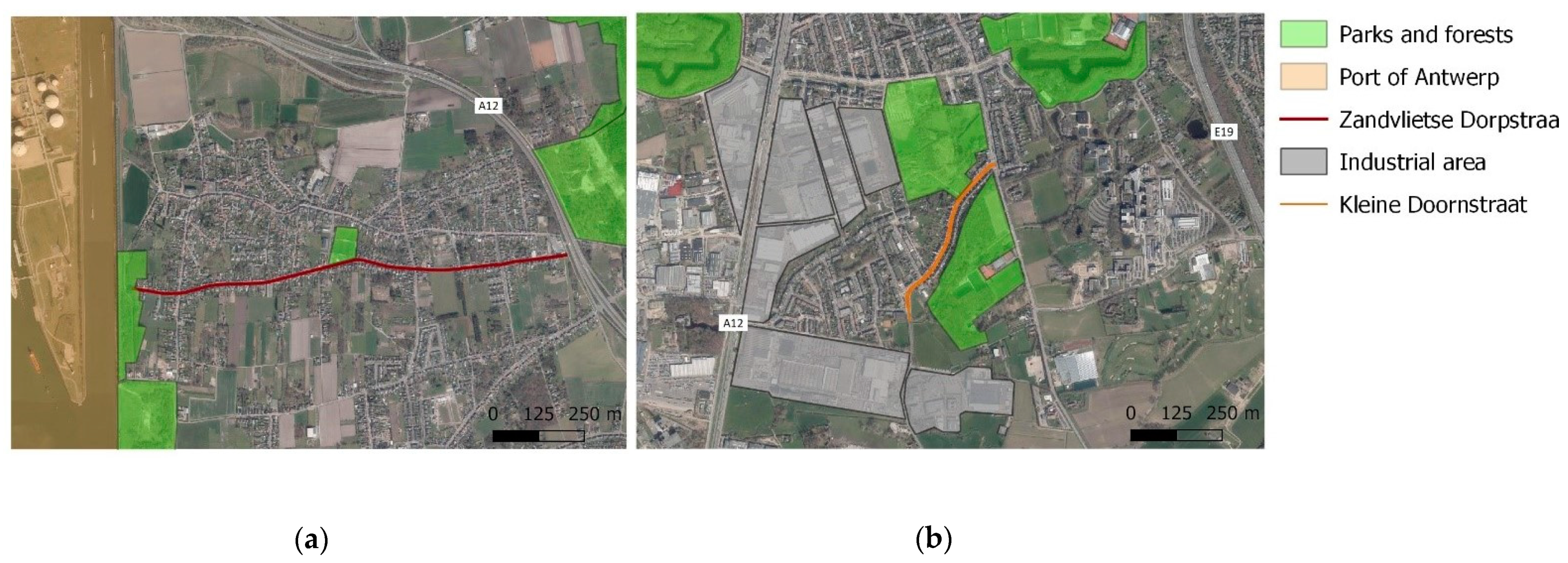

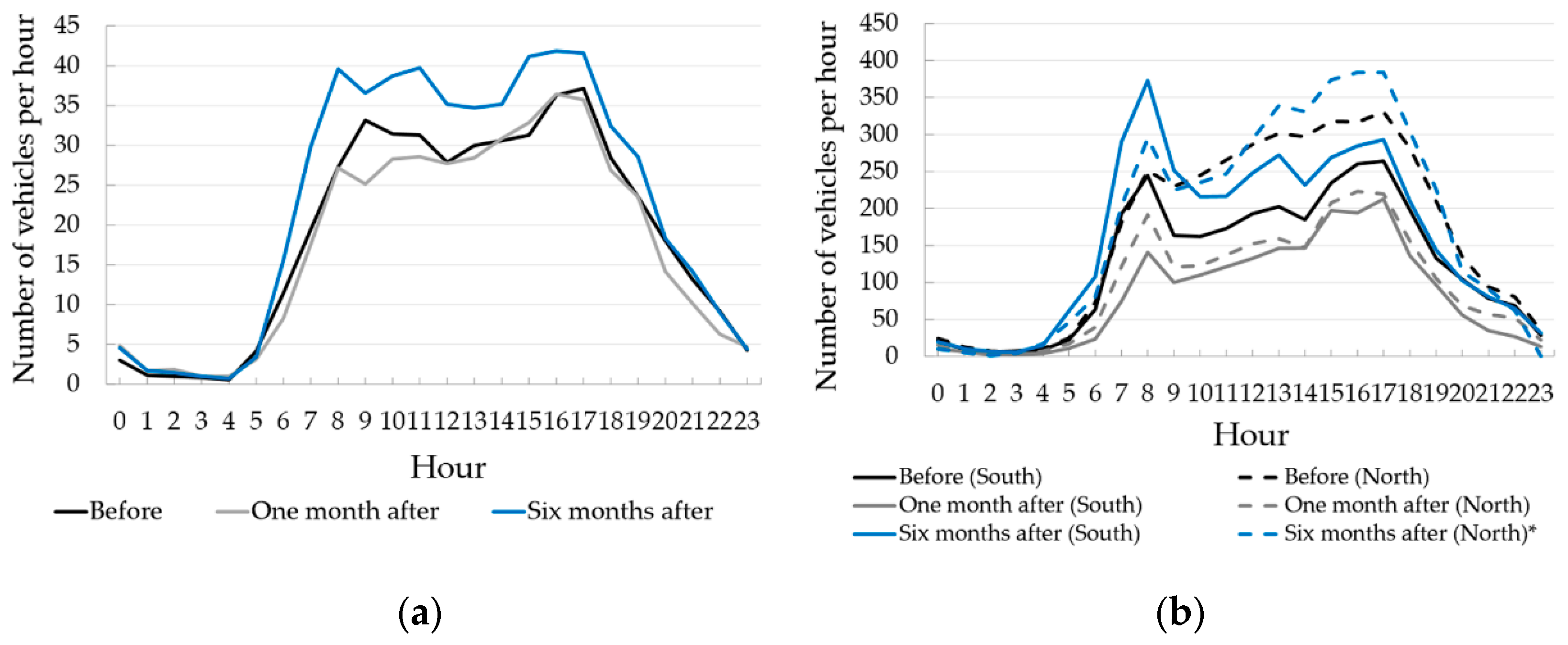
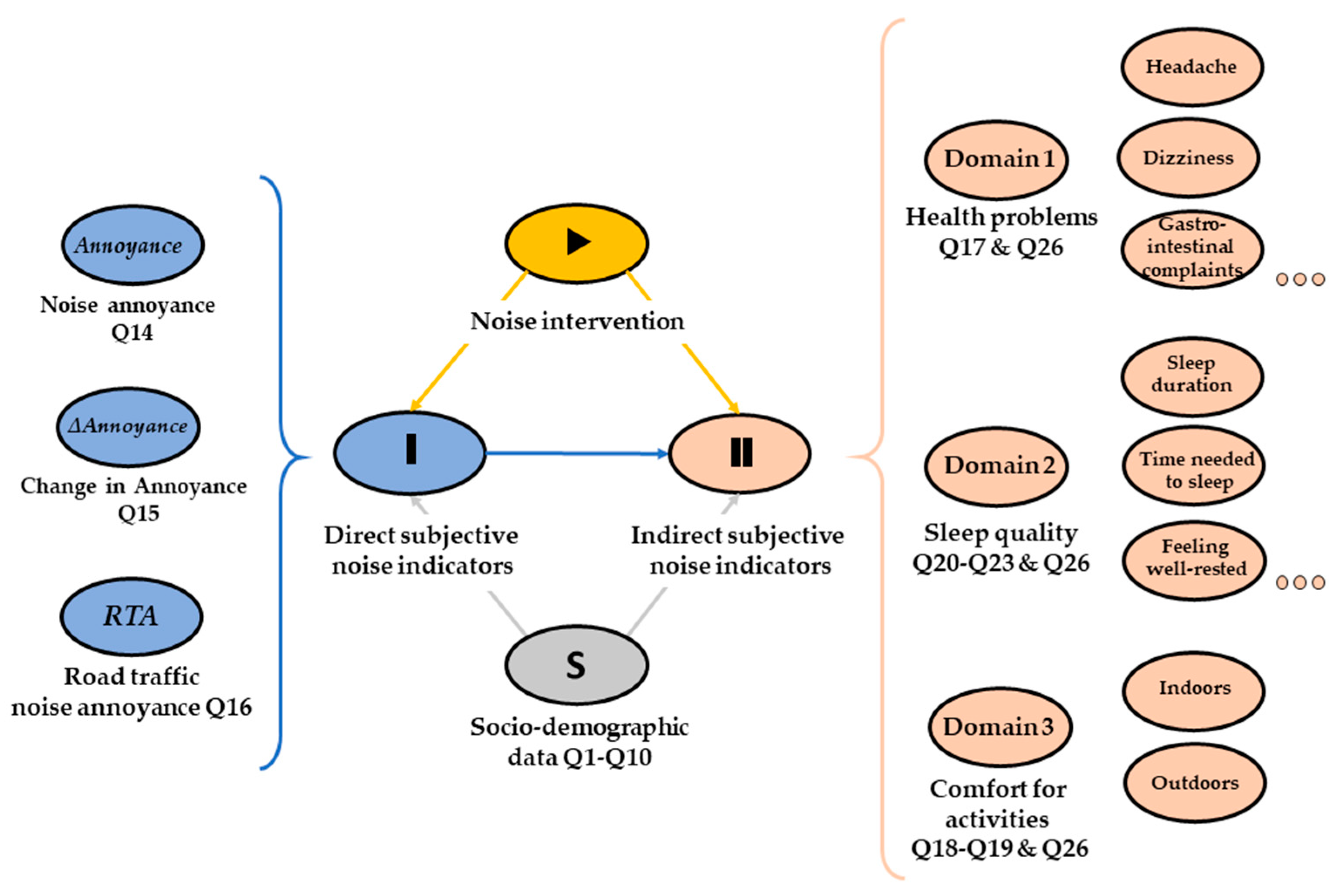
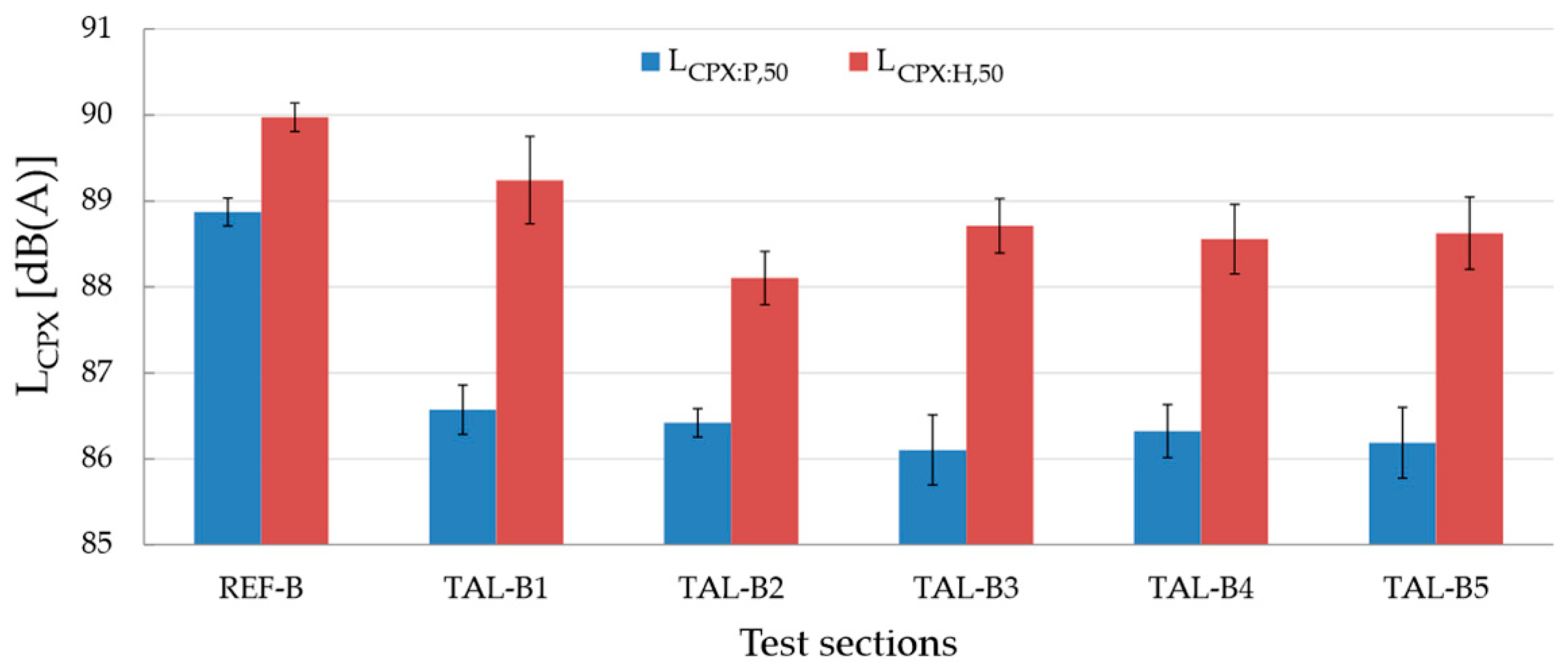
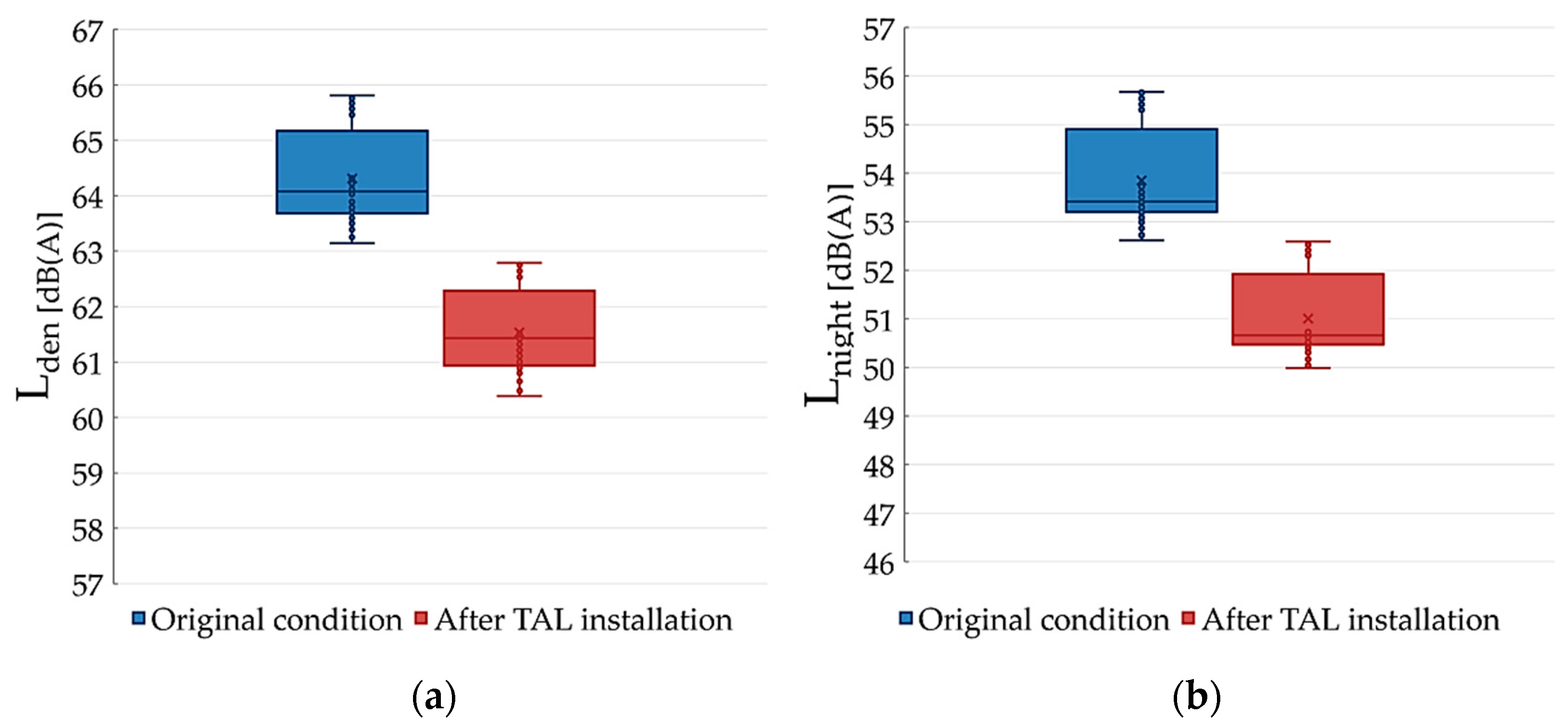

| Location | Street Name | Building Typology | Traffic Intensity | Heavy Traffic | Other Noise Sources |
|---|---|---|---|---|---|
| A | Zandvlietse Dorpstraat | detached and semi-detached | very low | no (only local traffic) | A12 highway (2 km) Railway (2 km) Port of Antwerp (2 km) |
| B | Kleine Doornstraat | terraced and semi-detached | average | yes | A12 and E19 highway (<1 km) Antwerp airport (5 km) Industrial area (<1 km) |
| Noise Intervention | Region/Location | Number of Respondents | |||||
|---|---|---|---|---|---|---|---|
| Control | Pre | Post 1 | Post 2 | Total | Resp. Rate | ||
| --- | North Antwerp Linkeroever South Antwerp Subtotal | 93 32 49 174 | - - - - | - - - - | - - - - | 93 32 49 174 | 28% 35% 18% 25% |
| TAL | A B Subtotal | - - - | 19 38 57 | 12 34 46 | 14 26 40 | 45 98 143 | 20% 35% 28% |
| Total | 174 | 57 | 46 | 40 | 317 | 26% | |
| Indicator | Control | TAL |
|---|---|---|
| Sex Women Men | 46.7% 53.3% | 52.1% 47.9% |
| Age | 39.2 ± 16.2 | 55.9 ± 15.4 |
| Level of education * Low Middle High | 11.8% 51.6% 36.6% | 17.1% 53.8% 26.4% |
| Inactive × | 39.7% | 46.9% |
| Living with children | 33.3% | 42.7% |
| Section | SPB (@ 50 km/h) [dB(A)] | Reduction [dB(A)] |
|---|---|---|
| REF-B | 71.0 | --- |
| TAL-B1 | 67.2 | 3.8 |
| TAL-B2 | 66.2 | 4.8 |
| TAL-B3 | 67.2 | 3.8 |
| TAL-B4 | 67.1 | 3.9 |
| TAL-B5 | 65.8 | 5.2 |
| Indicator | Case | |||
|---|---|---|---|---|
| Control | TAL | |||
| Pre | Post 1 | Post 2 | ||
| Annoyance * | 2.23 (0.99) | 2.75 (1.11) | 2.48 (1.01) | 2.42 (0.75) |
| ΔAnnoyance × | 0.46 (0.85) | 0.87 (0.79) | 0.16 (1.07) | 0.00 (1.22) |
| RTA * | 2.29 (1.08) | 2.86 (1.10) | 2.51 (0.92) | 2.41 (0.99) |
| Contrast | Annoyance | ΔAnnoyance | RTA | |
|---|---|---|---|---|
| p-Value | ||||
| Control | Pre | <0.01 | 0.02 | <0.01 |
| Post 1 | n.s. | n.s. | n.s. | |
| Post 2 | n.s. | n.s. | n.s. | |
| Pre | Post1 | n.s. | <0.01 | n.s. |
| Post2 | n.s. | <0.01 | n.s. | |
| Post 1 | Post 2 | n.s. | n.s. | n.s. |
| χ2(3) = 12.62, p = 0.006 | χ2(3) = 19.17, p = 0.000 | χ2(3) = 4.17, p = 0.006 | ||
| Measured %HA | Calculated %HA | ||||
|---|---|---|---|---|---|
| 80% | 60% | [4] 75% | [6] 72% | ||
| Control streets | 2.5 | 15.5 | . | . | |
| TAL | Pre | 7.1 | 26.8 | 17.5 | 15.2 |
| Post 1 | 2.2 | 13.1 | 13.2 | 11.8 | |
| Post 2 | 2.5 | 10.0 | |||
| Reduction pre to post (average) | 4.8 | 15.2 | 4.3 | 3.4 | |
| Domain | Indicator | Annoyance | ΔAnnoyance | RTA | |
|---|---|---|---|---|---|
| Physical complaints (1) | Headaches | ||||
| Fatigue | 0.14 * (n = 220) | 0.13 * (n = 211) | |||
| Dizziness | 0. | 0.15 * (n = 210) | |||
| Insomnia | 0.22 ** (n = 224) | 0.16 ** (n = 214) | |||
| Heart palpitations | 0.14 * (n = 221) | 0.15 * (n = 213) | |||
| Gastrointestinal complaints | 0.13 * (n = 223) | 0.12 * (n = 215) | |||
| Sleep quality (2) | Sleep duration (night) | ||||
| Sleep duration (day) | −0.13 * (n = 212) | ||||
| Time to fall asleep | |||||
| Waking up too early | 0.15 ** (n = 221) | 0.14 * (n = 213) | |||
| Difficulty waking up | |||||
| Feeling well-rested | −0.14 * (n = 220) | ||||
| Comfort level to perform activities (3) | Concentration during reading | In | 0.21 ** (n = 223) | 0.20 ** (n = 214) | |
| Out | 0.56 ** (n = 222) | 0.16 ** (n = 209) | 0.20 ** (n = 213) | ||
| Concentration during working or studying | In | 0.22 ** (n = 218) | 0.13 * (n = 210) | ||
| Out | 0.31 ** (n = 218) | 0.13 * (n = 205) | 0.18 ** (n = 208) | ||
| Concentration during watching TV | In | 0.18 ** (n = 223) | 0.14 * (n = 213) | ||
| Speech intelligibility during a conversation | In | 0.20 ** (n = 221) | 0.12 * (n = 213) | ||
| Out | 0.30 ** (n = 223) | 0.24 ** (n = 210) | 0.26 ** (n = 213) | ||
| Speech intelligibility on the telephone | In | 0.18 ** (n = 224) | 0.15 * (n = 211) | ||
| Out | 0.29 ** (n = 222) | 0.21 **(n = 209) | 0.22 ** (n = 212) | ||
| Relaxing or unwinding | In | 0.23 ** (n = 223) | 0.17 ** (n = 210) | 0.16 ** (n = 214) | |
| Out | 0.38 ** (n = 222) | 0.26 ** (n = 209) | 0.24 ** (n = 213) | ||
Publisher’s Note: MDPI stays neutral with regard to jurisdictional claims in published maps and institutional affiliations. |
© 2021 by the authors. Licensee MDPI, Basel, Switzerland. This article is an open access article distributed under the terms and conditions of the Creative Commons Attribution (CC BY) license (https://creativecommons.org/licenses/by/4.0/).
Share and Cite
Grangeiro de Barros, A.; Kampen, J.K.; Vuye, C. The Impact of Thin Asphalt Layers as a Road Traffic Noise Intervention in an Urban Environment. Sustainability 2021, 13, 12561. https://doi.org/10.3390/su132212561
Grangeiro de Barros A, Kampen JK, Vuye C. The Impact of Thin Asphalt Layers as a Road Traffic Noise Intervention in an Urban Environment. Sustainability. 2021; 13(22):12561. https://doi.org/10.3390/su132212561
Chicago/Turabian StyleGrangeiro de Barros, Ablenya, Jarl K. Kampen, and Cedric Vuye. 2021. "The Impact of Thin Asphalt Layers as a Road Traffic Noise Intervention in an Urban Environment" Sustainability 13, no. 22: 12561. https://doi.org/10.3390/su132212561
APA StyleGrangeiro de Barros, A., Kampen, J. K., & Vuye, C. (2021). The Impact of Thin Asphalt Layers as a Road Traffic Noise Intervention in an Urban Environment. Sustainability, 13(22), 12561. https://doi.org/10.3390/su132212561







